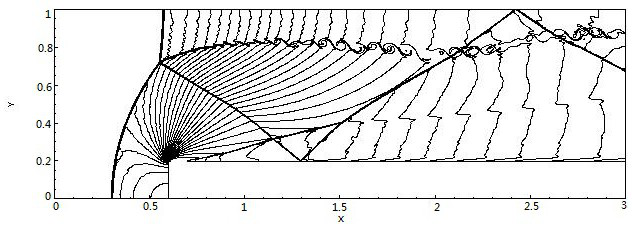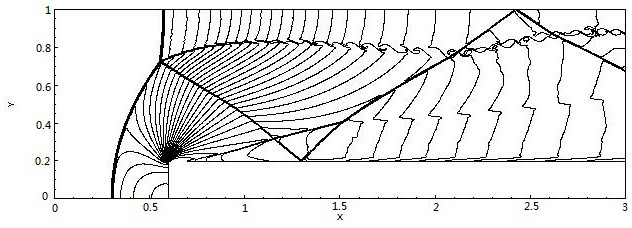A new weno format construction method under the framework of trigonometric functions
A technology of trigonometric functions and construction methods, applied in complex mathematical operations, special data processing applications, design optimization/simulation, etc., can solve problems such as difficult implementation and complex calculations, achieve small truncation errors, simplicity and easier expansion, and avoid non-physical oscillating effect
- Summary
- Abstract
- Description
- Claims
- Application Information
AI Technical Summary
Problems solved by technology
Method used
Image
Examples
Embodiment 1
[0112] Embodiment 1, step problem. This problem is a classic example proposed by Emery in 1968 to test the nonlinear hyperbolic conservation law scheme. The initial data is that the Mach number of the horizontal incoming flow is 3, the density is 1.4, the horizontal velocity is 3, the vertical velocity is 0, the pressure is 1, the pipeline area is [0,3]×[0,1], and the distance from the left boundary is 0.6 There is a step with a height of 0.2, and the step extends to the end of the pipe. The upper and lower boundaries are reflection boundaries, the left boundary is the incoming flow boundary, and the right boundary is the outflow boundary. Figure 1a-1c The density contour plot at t=4 is given.
Embodiment 2
[0113] Embodiment 2, double Mach reflection problem. This problem describes the changes that occur when a strong shock wave at an angle of 60° to the x-axis hits a reflecting wall, and the incoming flow is a strong shock wave with a Mach number of 10. The calculation area is [0,4]×[0,1]. Region bottom from The reflective boundary condition starts at y=0, and the other bottom boundaries (from x=0 to That part) is the wavefront condition. Figure 2a-2c The density contour map in the area [0,3]×[0,1] at t=0.2 is given.
Embodiment 3
[0114] Embodiment 3, the problem of mutual interference between shock wave and eddy current. The shock wave with a Mach number of 1.1 is located at x=0.5 and is perpendicular to the x-axis. The initial state of the shock wave is The small eddy is located to the left of the shock and its center is at (x c ,y c )=(0.25,0.5). The eddy current can be regarded as the disturbance of the velocity, temperature and entropy of the mean flow, expressed as:
[0115]
[0116] where, τ=r / r c , ε=0.3, r c =0.05, α=0.204, γ=1.4, and the calculation area is [0,2]×[0,1]. Figures 3a-3c The pressure contour map in [0,1]×[0,1] area is given at t=0.35. Figures 4a-4c The pressure contour map in [0.4,1.45]×[0,1] area is given at t=0.6. Figures 5a-5c The pressure contour map in the [0,2]×[0,1] region is given at t=0.8.
PUM
 Login to View More
Login to View More Abstract
Description
Claims
Application Information
 Login to View More
Login to View More - R&D
- Intellectual Property
- Life Sciences
- Materials
- Tech Scout
- Unparalleled Data Quality
- Higher Quality Content
- 60% Fewer Hallucinations
Browse by: Latest US Patents, China's latest patents, Technical Efficacy Thesaurus, Application Domain, Technology Topic, Popular Technical Reports.
© 2025 PatSnap. All rights reserved.Legal|Privacy policy|Modern Slavery Act Transparency Statement|Sitemap|About US| Contact US: help@patsnap.com



